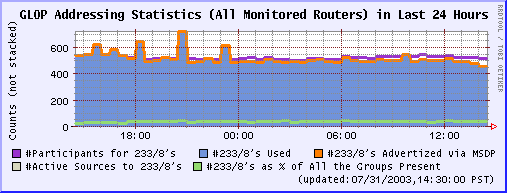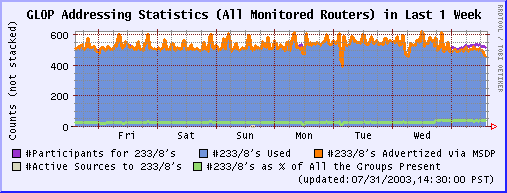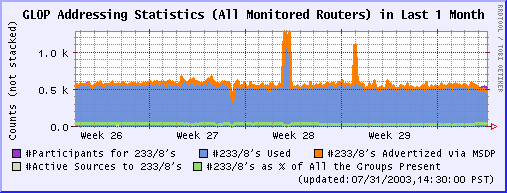New protocols and policies are emerging for static allocation of multicast addresses. GLOP is one such policy that aims at allocating unique chunks of 233/24 address block to different AS'. The following graphs display some basic statistics related to the usage of GLOP addresses. For more information on GLOP, please follow the link to A Brief Introduction to GLOP. List of Available Graphs: More Info: A brief introduction to GLOP addressing: For a long time the multicast address allocation has been dynamic and done with the help of applications like SDR that use Session Announcement Protocol, SAP. However, with the development of new multicast applications, need for alternative mechanisms for multicast address allocation has surfaced. Consequently, several new protocols are under development and new policies are being used for the purpose. GLOP is one such policy the usage of which is still experimental in nature. GLOP aims to allocate the 233/8 range of multicast addresses amongst different ASes such that each AS is statically allocated /24 block of multicast addresses. Following example, from the original draft (draft-ietf-mboned-glop-addressing-00.txt ), explains this allocation: "Consider, for example, AS 5662. Written in binary, left padded with 0s, we get 0001011000011110. Mapping the high order octet to the second octet of the address, and the low order octet to the third octet, we get 233.22.30/24." Following is the illustration of the IP Address structure (as given in draft-ietf-mboned-glop-addressing-00.txt): 0 1 2 3 4 5 6 7 8 9 0 1 2 3 4 5 6 7 8 9 0 1 2 3 4 5 6 7 8 9 0 1 +-+-+-+-+-+-+-+-+-+-+-+-+-+-+-+-+-+-+-+-+-+-+-+-+-+-+-+-+-+-+-+-+ | 233 | 16 bits AS | local bits | +-+-+-+-+-+-+-+-+-+-+-+-+-+-+-+-+-+-+-+-+-+-+-+-+-+-+-+-+-+-+-+-+ go top Utility of the results and how to interpret the graphs: As mentioned above GLOP is still experimental in usage. The aim of the statistics presented in this section is to gauge the usage of 233/8 address space as well as the activity in these groups. The last plot; i.e. what %age of active groups that use GLOP addressing summarizes the extent of use of GLOP address space. The proximity of the plot of number of MSDP announcements for the groups using GLOP address space to that of total number groups using GLOP addresses signifies that most of the these groups originate from the domain running sparse mode. Plots for number of participants and active sources tell how extensively these groups are being used. In comparison with the plots in the section, Session and Membership Monitoring , plots in this section show that the number of active sources in group using GLOP address space is much higher. This implies that groups using GLOP address space are much more active -- actual contents being sourced to the groups -- than the normal groups. go top
|


 Last 24 Hours
Last 24 Hours Last 1 Week
Last 1 Week Last 1 Month
Last 1 Month